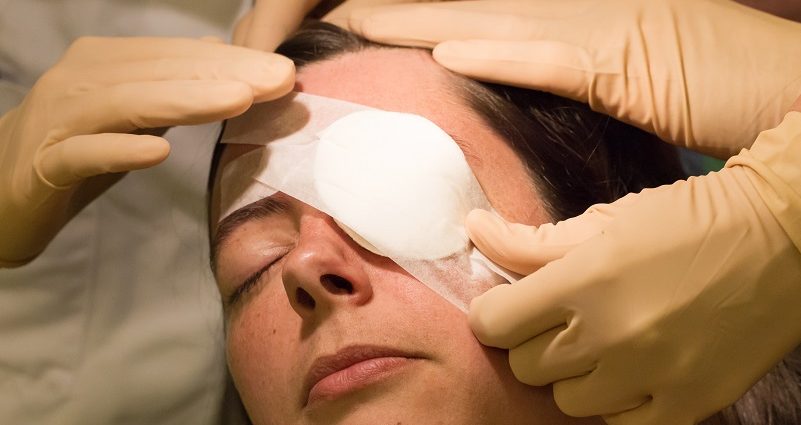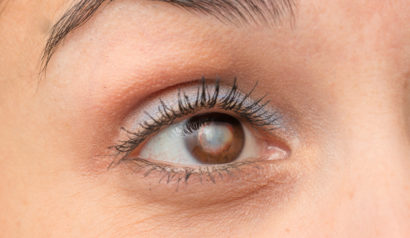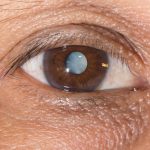Cataract Surgery Recovery
Medically Reviewed by: Dr. David Evans

Standard cataract surgery can be performed in approximately 10 minutes and boasts an extremely high success rate with a low risk of complications. The vast majority of patients achieve improved, sharper vision, but this change is not necessarily immediate.
Cataract surgery recovery time tends to be minimal, but there are various factors that can impact the speed of recovery. It’s important to discuss all aspects of the procedure, including things like cost, possible complications and the recovery process with the cataract surgeon or eye doctor prior to treatment to ensure the best chance of success.
Immediately After Surgery
Cataract surgery is an outpatient procedure performed using local anesthetic. Immediately after surgery, a lightweight shield will typically be placed over the eye to provide protection against accidental contact, or inadvertent rubbing. The patient is moved from the surgical suite to a recovery area to rest for about 30 minutes. This allows any lingering effects of sedation to wear off before the patient leaves the office. It also affords an opportunity for the doctor and staff to review important details about the patient’s recovery, and schedule the first follow-up appointment.
The patient is not able to drive immediately after cataract surgery, so arrangements will need to be made to have someone drive the patient home. A pair of dark, protective sunglasses will be provided to help shield the patient’s eyes on the drive home.
Once home, the eye shield can be removed, but it is recommended that it be worn while sleeping for at least a few days. It may take a few hours to adapt to the artificial lens and cataract removal after the shield is removed. Most patients experience much clearer vision, and colors appear vibrant. During this adjustment period there may be some blurred or otherwise distorted vision. This is normal and dissipates quickly.
Although it is typically okay to resume regular activities like watching TV or even reading, most doctors advise their patients to relax and rest in the hours immediately following surgery. Napping for a couple hours can be helpful if the patient feels a little out of sorts.
The surgeon will provide a prescription for eye drops that are used to control inflammation and prevent infection. The prescription is typically picked up after surgery. In some cases patients plan ahead to have the prescription filled before surgery, so that they can go directly home without stopping to pick up the medication(s). The eye surgeon will discuss the details about how to use the drops, when and for how long. (Typically they will be administered multiple times a day.)
Patients rarely feel any pain after cataract surgery, but in right after treatment they may experience a burning, stinging or gritty sensation. Although this can be a cause of discomfort, it isn’t something to be alarmed about.
Follow-up Appointments
The first follow-up appointment is typically the day after treatment. During this appointment, the surgeon reviews the medications and answers any lingering questions related to schedule and/or dosage.
The patient should plan to get a ride to the follow-up appointment, but barring any setbacks or complications, should be cleared for driving thereafter. (Read more about driving after cataract surgery.)
Additional follow-up visits may occur with a general eye care provider rather than the cataract surgeon. These visits are scheduled on a case-by-case basis.

Ongoing Cataract Surgery Recovery
In the days and weeks after surgery, it’s important to continue to wear dark, ultraviolet (UV) protective sunglasses whenever outdoors.
Within a week of surgery, patients can expect to return to a normal routine, including work. It’s fine to shower and bathe, but great care must be taken to avoid getting water in or near the operated eye. It is best to speak with the surgeon about when it’s okay to restart specific activities like running, going to the gym, swimming, playing sports, etc. It’s also important to consider purchasing protective sport/safety goggles to use whenever participating in an activity that could potentially injure the eye.
Unless otherwise directed, the medicated eye drops should be used per the schedule set forth by the surgeon. If dry eye becomes an issue, the standard prescriptions may be supplemented with over-the-counter artificial tears or prescription dry eye treatment.
Patients should not be alarmed to experience glare and halos around bright lights in the days and weeks after surgery. These are relatively common side effects. However, if these symptoms get worse, or if they don’t eventually subside, it’s important to relay these concerns to the eye doctor.
As described above, there should be no pain after surgery, but the eyes may be more sensitive to light, wind and touch. This is normal and no cause for concern. But if the sensitivity continues or there is noticeable discomfort, it is best to contact the eye doctor for another follow-up.
Cataract surgery is designed primarily to clear up the clouding of vision caused by cataracts. Newer-technology lenses can also help to treat presbyopia (age-related nearsightedness) at the same time. This procedure is sometimes referred to as refractive cataract surgery or presbyopia surgery. The surgeon can provide further details about the options available to treat presbyopia so that the patient can potentially be totally glasses- or contacts-free after surgery for both near and distance vision. Within two or three months after surgery, patients should not feel any discomfort or sensitivity, and vision should be clear.
Secondary Cataracts and Laser Capsulotomy
A common complication of cataract surgery is the development of what is sometimes referred to a secondary cataract. Unlike primary cataracts, which develop in the lens of the eye, secondary cataracts develop in the posterior portion of the lens capsule. This capsule — which holds the natural lens in place — is not removed during cataract surgery. It is left in place in order to hold the artificial lens (IOL) and limit the risk of complications.
Fortunately, the vision loss that accompanies secondary cataracts can be corrected through a painless outpatient procedure called laser capsulotomy. This quick, incision-free procedure involves three quick and easy steps:
- The eye is dilated with drops
- A laser is used to create small holes in the clouded lens capsule
- Anti-inflammatory eye drops are applied to prevent swelling
After laser capsulotomy the patient can return to normal activity immediately, including driving. Laser capsulotomy can cause some eye floaters, but these should subside in the days after treatment. Vision should improve within a day.
Once the lens capsule is treated there can be no recurrence, so there is no need to worry about tertiary cataracts or any additional clouding.
Safe and Effective
Cataract surgery is one of the safest and most reliable medical procedures performed today. Millions of successful cataract surgeries are performed every year in the U.S., with an overall success rate exceeding 98 percent (according to the American Society of Cataract and Refractive Surgery). It’s one of the safest and most reliable procedures performed today.
Take the first step to better vision. Schedule a consultation with an experienced cataract surgeon to learn more about cataract surgery recovery.




